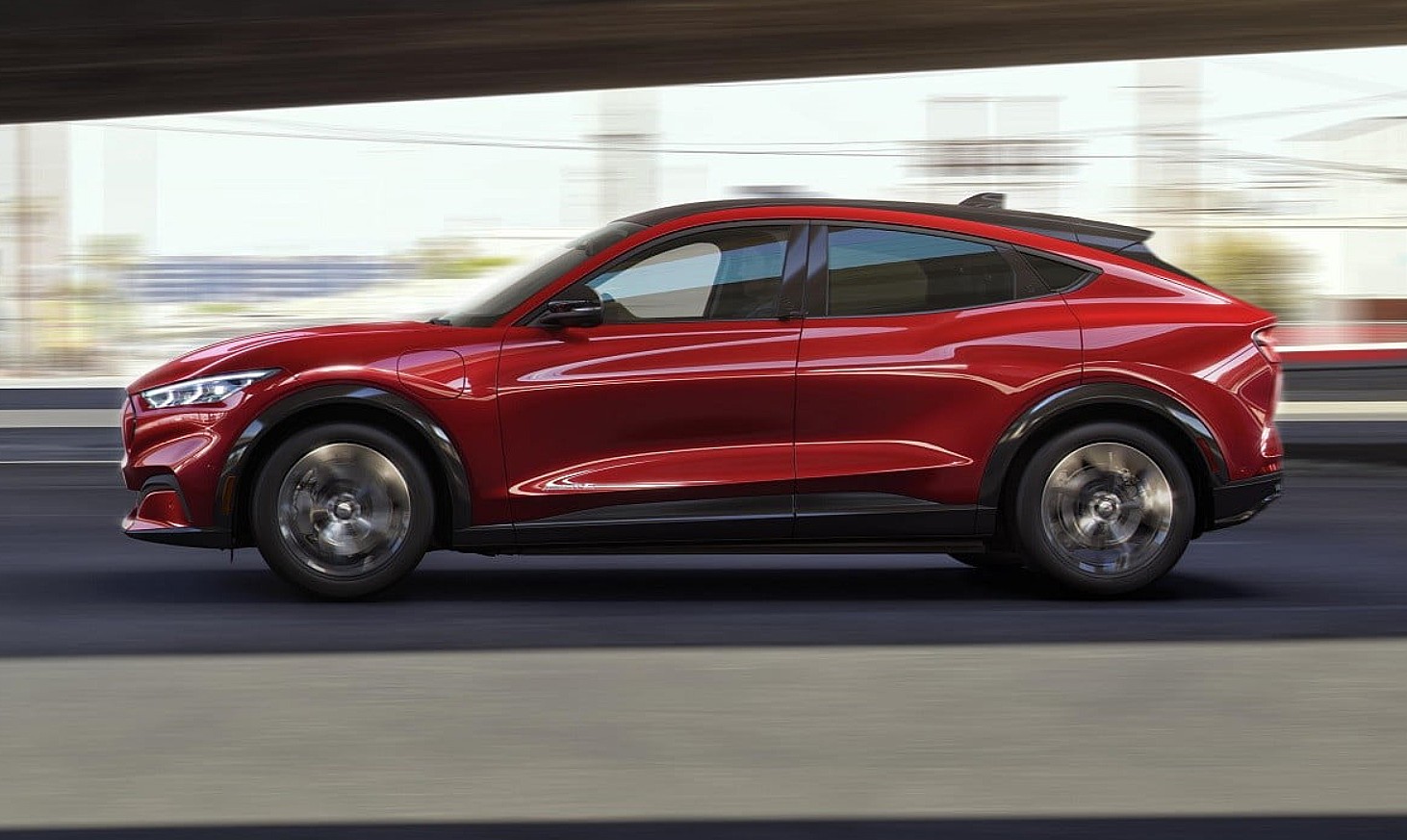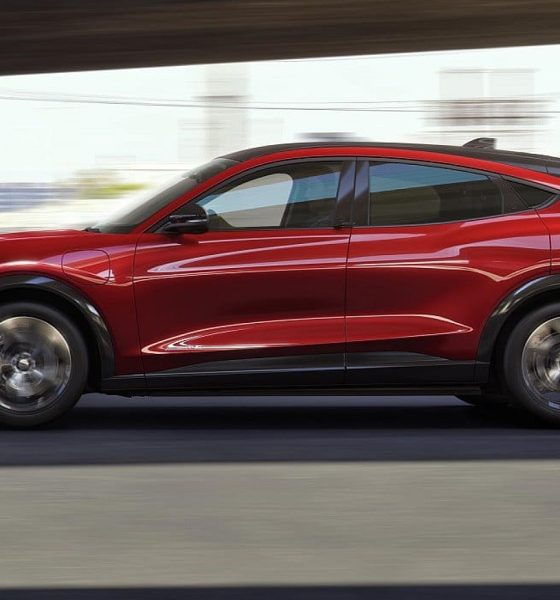The Ford Mustang Mach-E has made waves in the electric vehicle sector, thanks to its combination of features, price, and its rather controversial name. Recently, the American automaker formally took a select group of reviewers in London for a brief ride in its newest electric car. Reviews of the short drive gave some insight on how Ford’s newest battery electric vehicle will compare to its most comparable counterparts, like the upcoming Tesla Model Y.
Car Magazine writer Tom Wiltshire shared that his first impressions of the Mach-E was that the vehicle looked smaller than its 4.7-meter length. Strangely enough, the vehicle’s Mustang cues actually work for the Mach-E, giving the all-electric crossover a distinct look that’s good and aggressive at the same time.
Make no mistake, the Mach-E is still a premium electric vehicle, and Car Magazine‘s writers noted that. The vehicle’s instant torque provided a satisfying surge of acceleration. That being said, the Mach-E’s 0-60 mph prototype’s run of less than five seconds does not hit “in the same way a Tesla would,” according to Wilshire. It’s plenty quick — just not Tesla quick.
The Ford Mustang Mach-E offers three driving modes that are interestingly (or perhaps strangely) dubbed as “Whisper,” “Engage,” and “Unbridled.” It also offers a One-Pedal Mode for regenerative braking, a feature Car and Driver writers raved about on the Model S. The suspension was firm but the seats were comfortable, making the ride pleasant. Its refinement was easily on Tesla’s level, according to the reviewers. However, its EU-required noisemaker was mostly absent of the “distinctive but emotional” sound that Ford listed for the car.
The car’s interior felt impressively high-quality and while the vehicle’s dash screen was difficult to operate, its speaker system is unique in that it spanned the full width of the car. This provides the Mach-E with great interior sound, though it would meet some strong competition with the Model Y and its custom Tesla speakers, which have garnered rave reviews from owners.
While it is too early to tell if the Mach-E will be a success, the look of the car its performance during its short drive through the streets of London was fairly impressive. “If the price tag is right and Ford can pull off the same trick it’s been doing for many years this could be an EV well worth watching,” Wiltshire wrote.
The Ford Mustang Mach-E will be competing in the same segment as the Tesla Model Y, and while the two vehicles are comparable for sure in terms of pricing, acceleration, range, and cargo capacity, they could inevitably complement each other in the growing crossover market. With competitive pricing and specs right on point with the Model Y, many of the electric crossovers that have been produced by some of the legacy automakers such as the Jaguar I-PACE could be in for a rude awakening.
Ford’s move toward electric vehicles was complimented by Tesla CEO Elon Musk, who has always noted that his company’s competition does not lie within other EVs, but within carmakers who refuse to adapt to the electric revolution. Sustainable transportation options are becoming more prevalent as some of the largest automakers in the world are fully embracing the new wave of transportation.

News
Tesla FSD fleet is nearing 7 billion total miles, including 2.5 billion city miles
As can be seen on Tesla’s official FSD webpage, vehicles equipped with the system have now navigated over 6.99 billion miles.

Tesla’s Full Self-Driving (Supervised) fleet is closing in on almost 7 billion total miles driven, as per data posted by the company on its official FSD webpage.
These figures hint at the massive scale of data fueling Tesla’s rapid FSD improvements, which have been quite notable as of late.
FSD mileage milestones
As can be seen on Tesla’s official FSD webpage, vehicles equipped with the system have now navigated over 6.99 billion miles. Tesla owner and avid FSD tester Whole Mars Catalog also shared a screenshot indicating that from the nearly 7 billion miles traveled by the FSD fleet, more than 2.5 billion miles were driven inside cities.
City miles are particularly valuable for complex urban scenarios like unprotected turns, pedestrian interactions, and traffic lights. This is also the difference-maker for FSD, as only complex solutions, such as Waymo’s self-driving taxis, operate similarly on inner-city streets. And even then, incidents such as the San Francisco blackouts have proven challenging for sensor-rich vehicles like Waymos.
Tesla’s data edge
Tesla has a number of advantages in the autonomous vehicle sector, one of which is the size of its fleet and the number of vehicles training FSD on real-world roads. Tesla’s nearly 7 billion FSD miles then allow the company to roll out updates that make its vehicles behave like they are being driven by experienced drivers, even if they are operating on their own.
So notable are Tesla’s improvements to FSD that NVIDIA Director of Robotics Jim Fan, after experiencing FSD v14, noted that the system is the first AI that passes what he described as a “Physical Turing Test.”
“Despite knowing exactly how robot learning works, I still find it magical watching the steering wheel turn by itself. First it feels surreal, next it becomes routine. Then, like the smartphone, taking it away actively hurts. This is how humanity gets rewired and glued to god-like technologies,” Fan wrote in a post on X.
News
Tesla starts showing how FSD will change lives in Europe
Local officials tested the system on narrow country roads and were impressed by FSD’s smooth, human-like driving, with some calling the service a game-changer for everyday life in areas that are far from urban centers.

Tesla has launched Europe’s first public shuttle service using Full Self-Driving (Supervised) in the rural Eifelkreis Bitburg-Prüm region of Germany, demonstrating how the technology can restore independence and mobility for people who struggle with limited transport options.
Local officials tested the system on narrow country roads and were impressed by FSD’s smooth, human-like driving, with some calling the service a game-changer for everyday life in areas that are far from urban centers.
Officials see real impact on rural residents
Arzfeld Mayor Johannes Kuhl and District Administrator Andreas Kruppert personally tested the Tesla shuttle service. This allowed them to see just how well FSD navigated winding lanes and rural roads confidently. Kruppert said, “Autonomous driving sounds like science fiction to many, but we simply see here that it works totally well in rural regions too.” Kuhl, for his part, also noted that FSD “feels like a very experienced driver.”
The pilot complements the area’s “Citizen Bus” program, which provides on-demand rides for elderly residents who can no longer drive themselves. Tesla Europe shared a video of a demonstration of the service, highlighting how FSD gives people their freedom back, even in places where public transport is not as prevalent.
What the Ministry for Economic Affairs and Transport says
Rhineland-Palatinate’s Minister Daniela Schmitt supported the project, praising the collaboration that made this “first of its kind in Europe” possible. As per the ministry, the rural rollout for the service shows FSD’s potential beyond major cities, and it delivers tangible benefits like grocery runs, doctor visits, and social connections for isolated residents.
“Reliable and flexible mobility is especially vital in rural areas. With the launch of a shuttle service using self-driving vehicles (FSD supervised) by Tesla in the Eifelkreis Bitburg-Prüm, an innovative pilot project is now getting underway that complements local community bus services. It is the first project of its kind in Europe.
“The result is a real gain for rural mobility: greater accessibility, more flexibility and tangible benefits for everyday life. A strong signal for innovation, cooperation and future-oriented mobility beyond urban centers,” the ministry wrote in a LinkedIn post.
News
Tesla China quietly posts Robotaxi-related job listing
Tesla China is currently seeking a Low Voltage Electrical Engineer to work on circuit board design for the company’s autonomous vehicles.

Tesla has posted a new job listing in Shanghai explicitly tied to its Robotaxi program, fueling speculation that the company is preparing to launch its dedicated autonomous ride-hailing service in China.
As noted in the listing, Tesla China is currently seeking a Low Voltage Electrical Engineer to work on circuit board design for the company’s autonomous vehicles.
Robotaxi-specific role
The listing, which was shared on social media platform X by industry watcher @tslaming, suggested that Tesla China is looking to fill the role urgently. The job listing itself specifically mentions that the person hired for the role will be working on the Low Voltage Hardware team, which would design the circuit boards that would serve as the nervous system of the Robotaxi.
Key tasks for the role, as indicated in the job listing, include collaboration with PCB layout, firmware, mechanical, program management, and validation teams, among other responsibilities. The role is based in Shanghai.
China Robotaxi launch
China represents a massive potential market for robotaxis, with its dense urban centers and supportive policies in select cities. Tesla has limited permission to roll out FSD in the country, though despite this, its vehicles have been hailed as among the best in the market when it comes to autonomous features. So far, at least, it appears that China supports Tesla’s FSD and Robotaxi rollout.
This was hinted at in November, when Tesla brought the Cybercab to the 8th China International Import Expo (CIIE) in Shanghai, marking the first time that the autonomous two-seater was brought to the Asia-Pacific region. The vehicle, despite not having a release date in China, received a significant amount of interest among the event’s attendees.










